- 41-1/2-quart pressure cooker/canner holds 32 pint jars or 19 quart jars
- Made of durable, hand-cast aluminum with attractive satin finish
- Exclusive "metal-to-metal" sealing system for a steam-tight seal; no gaskets
- Geared steam gauge, automatic overpressure release; settings of 5 psi, 10 psi, and 15 psi
- 19 inches high with 15-1/4-inch inside diameter; made in USA

Looking for Can your own corn from corn-on-the-cob (easy, reliable how-to directions, recipe, with photos and free) in 2025? Scroll down this page and follow the links. And if you bring home some fruit or vegetables and want to can, freeze, make jam, salsa or pickles, see this page for simple, reliable, illustrated canning, freezing or preserving directions. There are plenty of other related resources, click on the resources dropdown above. If you are having a hard time finding canning lids, I've used these, and they're a great price & ship in 2 days.
If you have questions or feedback, please let me know! There are affiliate links on this page. Read our disclosure policy to learn more.
Can your own corn from corn-on-the-cob (easy, reliable how-to directions, recipe, with photos and free)
How to Can Corn - From Corn on the Cob!
using the "Hot Pack" method
Click here for a PDF print version
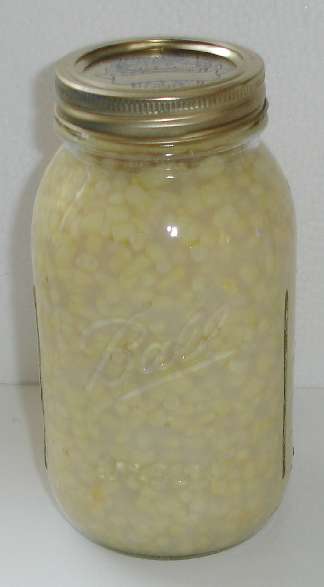 If
you don't have room in your freezer, but you want to be able to enjoy the corn
from your garden this winter, then home-canning your corn is the easy way to do
it. Here's how to do it, complete instructions in easy steps and completely
illustrated. The corn will taste MUCH better than any canned corn you've ever
had from a store. Frozen corn, of course, retains flavor better. If
you want directions for freezing corn,
click here. One other important note: you will need a Pressure Canner.
Corn is a low acid food, so you cannot use a water bath canner . It
must be a Pressure Canner. Pressure canners cost more than water bath canners,
but they are more versatile and last a lifetime, and your children and
grandchildren may be using it.
See this page for more information about pressure canners.
If
you don't have room in your freezer, but you want to be able to enjoy the corn
from your garden this winter, then home-canning your corn is the easy way to do
it. Here's how to do it, complete instructions in easy steps and completely
illustrated. The corn will taste MUCH better than any canned corn you've ever
had from a store. Frozen corn, of course, retains flavor better. If
you want directions for freezing corn,
click here. One other important note: you will need a Pressure Canner.
Corn is a low acid food, so you cannot use a water bath canner . It
must be a Pressure Canner. Pressure canners cost more than water bath canners,
but they are more versatile and last a lifetime, and your children and
grandchildren may be using it.
See this page for more information about pressure canners.
See this FAQ for more details: Can I use a water-bath canner instead of a Pressure Canner for low acid foods like corn?
Hot Pack v. Raw Pack? Hot pack means the corn is heated to boiling before we put it in the jars. Raw pack means it is placed into the jars without heating, and then the jars are processed in the canner. Which is better? Not much difference. Food safety experts prefer the hot pack method, because you can stir the corn the ensure it gets evenly and thoroughly heated. Raw pack instructions are here, should you prefer them.
Directions for Canning Corn at Home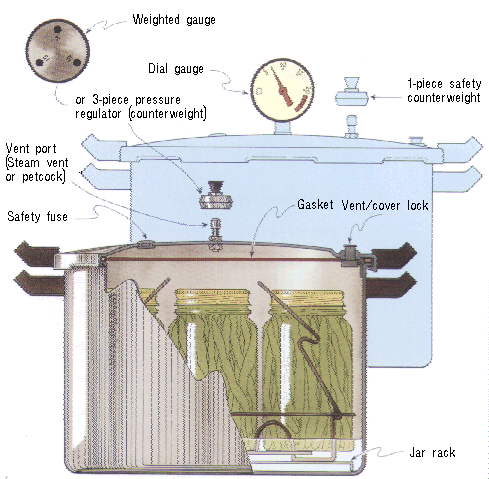
Ingredients and Equipment
- fresh corn on the cob - any quantity. I figure 1.5 ears per serving.
- 1 Large pot of boiling water (for filling the jars)
- 1 medium sized pot of boiling water (to heat the cut corn)
- 1 sharp knife
- 1 Large spoon or ladle
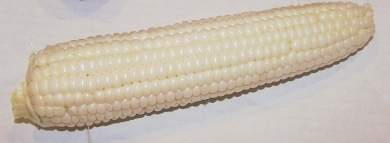
Ideal ear - ripe but not bloated. the kernels are still tender (easily punctured with your fingernail) and the juice is milky). White, yellow or bicolor types are all fine!
Instructions
Step 1 - Get yer corn!
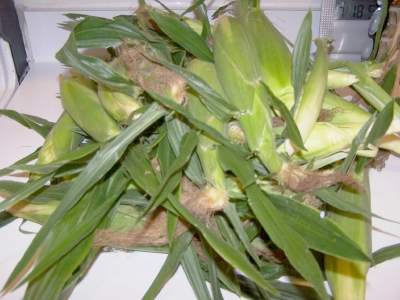 Start
with fresh corn on the cob - as fresh as you can get. If there is a
delay between harvesting and canning, put it in the refrigerator or put
ice on it. The sugars break down quickly at room temperature.
According to the USDA, about 32 pounds (in husk) of sweet corn is needed
per canner load of 7 quarts; an average of 20 pounds is needed per canner
load of 9 pints. Note that a bushel weighs 35 pounds and yields 6 to 11
quarts of canned corn, which is an average of 41/2 pounds of corn in the
husks per quart of finished canned corn.
Start
with fresh corn on the cob - as fresh as you can get. If there is a
delay between harvesting and canning, put it in the refrigerator or put
ice on it. The sugars break down quickly at room temperature.
According to the USDA, about 32 pounds (in husk) of sweet corn is needed
per canner load of 7 quarts; an average of 20 pounds is needed per canner
load of 9 pints. Note that a bushel weighs 35 pounds and yields 6 to 11
quarts of canned corn, which is an average of 41/2 pounds of corn in the
husks per quart of finished canned corn.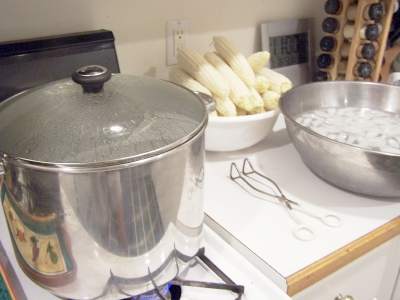
Step 2 - Get the pots ready
This is also a good time to get the canner filled (about 2/3 full) with water and start it heating.
Step 3 - Husk the corn
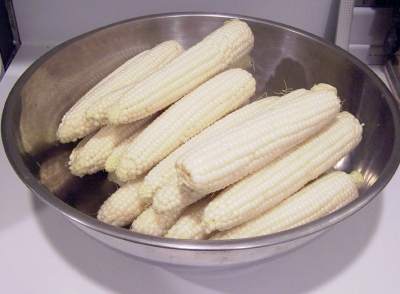 Husk
the corn and pick off as much of the silk as you can. A soft
vegetable brush is the fastest and easiest way to get the remaining silk
off - just don't be too rough with it.
Husk
the corn and pick off as much of the silk as you can. A soft
vegetable brush is the fastest and easiest way to get the remaining silk
off - just don't be too rough with it.
Step 4 - Cut the kernels from the cob
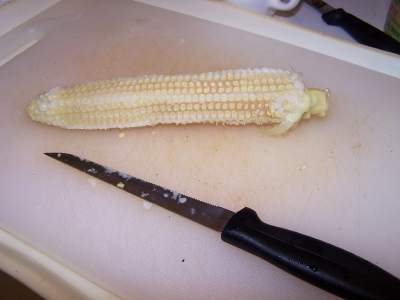 Obviously,
if you are canning the corn on the cob, skip this step.
Obviously,
if you are canning the corn on the cob, skip this step.
Whole Kernel Corn - Cut kernels from cob about 2/3 to 3/4 the depth of the kernels. I hold the ear by the small end, and slide the knife down the ear. See the next photo.
Cream Style Corn - Cut kernel tips about 1/2 deep and scrape the cobs with the back of a knife to remove the juice and the heart of the kernel.
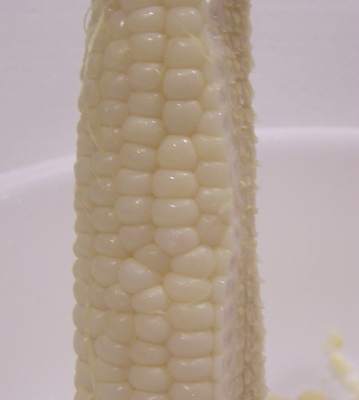 Another
way to prepare cream style corn for canning is to cut and scrape the corn
from the cob without blanching. Place the cut corn in a double boiler, and
heat with constant stirring for about 10 minutes or until it thickens.
Another
way to prepare cream style corn for canning is to cut and scrape the corn
from the cob without blanching. Place the cut corn in a double boiler, and
heat with constant stirring for about 10 minutes or until it thickens.
You don't need a special tool, just a very sharp knife! Some folks use an electric carving knife and report this is the easiest method, and a few use a meat slicer.
However, a number of people wrote in to point out that they prefer one of the tools below, as do I, often because it is easier for them due to arthritis, or simply faster.
See here for related tools, equipment, supplies on Amazon See here for related tools, equipment, supplies on Amazon See here for related tools, equipment, supplies on Amazon See here for related tools, equipment, supplies on Amazon
As the corn piles up in your bowl, it will look like this!
 Close
up, the corn comes off in strips. As you put these in the bag,
they will easily separate into separate kernels.
Close
up, the corn comes off in strips. As you put these in the bag,
they will easily separate into separate kernels.
Step 5 - Get a pot of water boiling
You will need this to supplement the water in step 10 to fill the jars after you pack them with corn.
 Step
6 - Heat the cut corn
Step
6 - Heat the cut corn
Dump the cut kernels into a measure cup (so you know how much you have) and then put the corn into a saucepan or pot. Add 1 cup of hot water for each quart of corn. Heat the corn to boiling and simmer 5 minutes.
Step 7 - Pack the jars
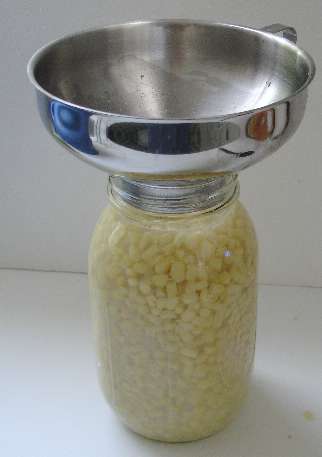 Fill
jars with corn, leaving 3/4 to 1 inch headspace (corn tends to expand
more than other vegetables).
Fill
jars with corn, leaving 3/4 to 1 inch headspace (corn tends to expand
more than other vegetables).
Step 8 - Fill with hot water
Be sure to include enough cooking liquid to cover the corn and jostle out any air bubbles that may be trapped. You may add additional plain boiling water from step 7, if you are short on liquids from the heated corn. Still leave 3/4 to 1 inch headspace
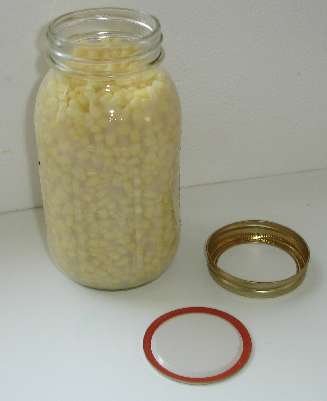
Step 9 - Put the lids and rings on the jars
Wipe the rims of the jars, put the lids on and then the rings on snugly, not not TOO hard.
Step 10 - Process the jars in the pressure canner
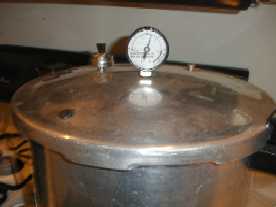 Follow
the directions with your pressure canner and process the jars for the
times and pressures below depending upon your altitude, type of pressure
canner and jar size. My canner is a dial-type, shown at left.
Follow
the directions with your pressure canner and process the jars for the
times and pressures below depending upon your altitude, type of pressure
canner and jar size. My canner is a dial-type, shown at left.
Once the gauge hits 10 or 11 pounds (depending on the type you have), start your timer going - see the table below for the time for the size of jar and altitude. Adjust the heat, as needed, to maintain that pressure.
Note: the chart below will help you determine the right processing time and pressure, if you have a different type of canner, or are above sea level.
It is important to learn how to operate your pressure canner by reading the owner's manual that came with your particular canner. If you cannot find your owner's manual, you can obtain find one online: Here is where to find some common manufacturer's manuals:
or by contacting the company that made your canner. Give the model number to the manufacturer, and they will send you the right manual. More information about pressure canners and a variety of models you can order.
|
Processing time for corn in a dial-gauge pressure canner |
|||||
| Hot Pack | Canner Pressure (PSI) at Altitudes of | ||||
| Jar Size | Process Time | 0 - 2,000 ft | 2,001 - 4,000 ft | 4,001 - 6,000 ft | 6,001 - 8,000 ft |
| Pints | 55 min | 11 lb | 12 lb | 13 lb | 14 lb |
| Quarts | 85 min | 11 | 12 | 13 | 14 |
|
Processing time for corn in a weighted-gauge pressure canner |
|||
| Hot Pack | Canner Pressure (PSI) at Altitudes of | ||
| Jar Size | Process Time | 0 - 1,000 ft | Above 1,000 ft |
| Pints | 55 min | 10 lb | 15 lb |
| Quarts | 85 | 10 | 15 |
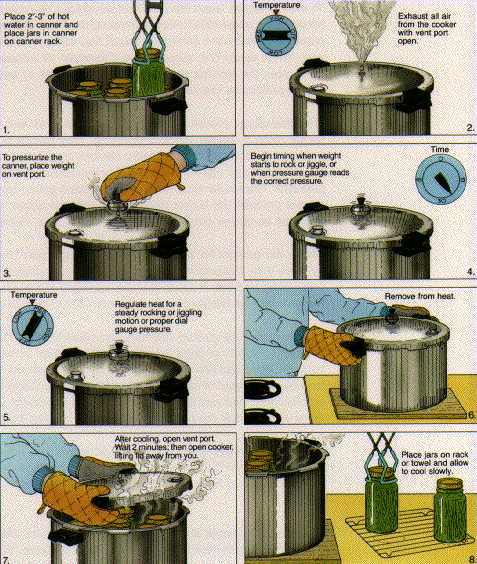
Step 11 - Done!
 When
the processing time from the chart above is up, turn off the heat, and
allow the pressure canner to cool and the pressure to drop to zero
before opening the canner. Let the jars cool without being
jostled. After the pressure drops to zero (usually, you can tell but the
"click" sound of the safety release vents opening, as well as but the
gauge. Let the pressure in the canner drop to zero by itself. This
may take 45 minutes in a 16-quart canner filled with jars and almost an
hour in a 22-quart canner. If the vent is opened before the pressure
drops to zero OR if the cooling is rushed by running cold water over the
canner, liquid will be lost from the jars. Too rapid cooling causes loss
of liquid in the jars!
When
the processing time from the chart above is up, turn off the heat, and
allow the pressure canner to cool and the pressure to drop to zero
before opening the canner. Let the jars cool without being
jostled. After the pressure drops to zero (usually, you can tell but the
"click" sound of the safety release vents opening, as well as but the
gauge. Let the pressure in the canner drop to zero by itself. This
may take 45 minutes in a 16-quart canner filled with jars and almost an
hour in a 22-quart canner. If the vent is opened before the pressure
drops to zero OR if the cooling is rushed by running cold water over the
canner, liquid will be lost from the jars. Too rapid cooling causes loss
of liquid in the jars!
Later, when you are ready to serve the corn, it just takes about 3 or 4 minutes in the microwave (from frozen) or in the top of a double boiler. The corn doesn't need to be "cooked", just heated up!
Tips:
- Harvest early in the morning, especially if the weather is hot, to get peak flavor.
- Harvest the corn at its peak maturity (milky fluid in the kernels, kernels tender, and not bloated). Immature corn is watery when cooked and over-ripe corn is chewy and doughy.
- Process promptly after harvesting, or keep cooled in the fridge or with ice until then.
Frequently Asked Questions
- What causes corn to turn brown during processing?
This occurs most often when too high a temperature is used causing caramelization of the sugar in the corn. It may also be caused by some minerals in the water used in canning.
- Aspirin / Salicylic Acid? My mother canned corn using salicylic acid.
The only recipe I have is: 7 cups corn 1/2 cup salt 1 cup sugar 1t.salicylic
acid 1 cup water Let boil several minutes. What do I need to know to can
corn using this method?
You may have heard of someone's grandmother canning corn by boiling the corn, adding aspirin or salicylic acid from the drugstore, then sealing the corn in jars with no further processing. According to the University of Illinois, a recipe circulated several years ago, using aspirin to acidify tomatoes and beans for canning. Aspirin is not recommended for canning. While it contains salicylic acid, it does not sufficiently acidify low acid foods like tomatoes or beans for safe hot water bath canning. Low acid foods (without added acids) should only be processed safely in a Pressure Canner. Lemon juice or vinegar is recommended to acidify tomato products for safe water bath processing. You can also see an article in JAMA (the Journal of the American Medical Association, Vol. 289 No. 13, April 2, 2003, titled "Is salicylic acid as a food preservative harmful?"; from which the abstract states: "salicylic acid, in the ways in which it is used in the preparation of food products, is not only not harmful, but is a preservative to health, inasmuch as the process of decomposition which it prevents would be far more dangerous."
Comments and Tips
- Comments from a visitor on August 15, 2009: "Hi, I just wanted to share that we use an electric knife to remove the blanched corn from the cob. It is the easiest quickest way we have found for this part of the process. Last night we processed 10 dozen ears of corn in two hours. Please pass it on. My 80 year old grandma taught me this trick! Thanks, kim"
Pressure canners!
If you want to can low-acid foods such as red meats, sea food, poultry, milk, and all fresh vegetables with the exception of most tomatoes, you will need a Pressure Canners. These foods fit into the low acid group since they have an acidity, or pH level, of 4.6 or greater. The temperature which must be reached and maintained (for a specified amount of time) to kill the bacteria is 240 F. Pressure canning is the only canning method recommended safe by the U.S.D.A. for low-acid foods such as vegetables, meats, and fish. Ordinary water bath canners can only reach 212 F and cannot to kill the types of bacteria that will grow in low acid foods. This temperature can be reached only by creating steam under pressure as achieved in quality pressure canners.
There are several manufacturers of pressure canners. The two leading ones are Presto and All American (Wisconsin Aluminum). They are more expensive than water bath canners, but extremely well built - I bought mine in 1988 and it still looks and works like new!
|
Click here for related items on Amazon |
BUT, with a Pressure Canner it's easy. And although a
pressure canner costs $100 to $200 (see this page for pressure canners
models, makes and prices), they last a lifetime, and your children and
grandchildren may be using it. You can also find free information from
the USDA in this PDF file (it will take a while to load!) about
selecting and using canners here! We have hundreds of free recipes and directions, but if you want to buy a pressure canning cookbook, see at left. |
 Presto 01781 23-Quart Pressure Cooker/Canner
Presto 01781 23-Quart Pressure Cooker/Canner

See here for related tools, equipment, supplies on Amazon |
Presto 01755 16-Quart Pressure Cooker/CannerThis is usually about $72 PLUS SHIPPING. (which is also a GREAT price for a Pressure Canner, although, I think the 23 qt above for $7 more is a better value.). Click on the links at left or above for more info and current pricing. It is available from the sellers .com (click on the box link at left) Click here for replacement Presto Pressure Canner Gaskets
|
|
| All-American 941 Pressure Canner All-American 930 Pressure Canner See here for related tools, equipment, supplies on Amazon |
All American Pressure Canner and Cookers - In 3 SizesClick on the box at left to order See the seller's website for features, pricing and user reviews! This is usually one of the best-priced pressure canners. There is also a 16 quart version for even less. Click on the links at left or above for more info and current pricing. Click on the box at left for more information. |
|

All-American 941 Pressure Canner |
||
|
See here for related tools, equipment, supplies on Amazon |
Pressure canners for Induction Cooktops!Features
|
|
| See here for related tools, equipment, supplies on Amazon See here for related tools, equipment, supplies on Amazon |
Looking for canning equipment and supplies?Water bath canner with a jar rack Pressure canners for gas, electric and induction stoves: Presto 23Qt or T-fal 22Qt Canning scoop (this one is PERFECT) Ball Blue book (most recent version) Jars: 8oz canning jars for jams
Find Other types of farms:Farm markets and roadside stands Road trips and camping resources Local Honey, apiaries, beekeepers Consumer fraud and scams information Home canning supplies at the best prices on the internet! Maple Syrup Farms, sugarworks, maple syrup festivals Environmental information and resources Farms For Your Event for birthday parties, weddings, receptions, business meetings, retreats, etc. Festivals - local fruit and vegetable festivals
With this Presto 23 quart pressure canner and pressure cooker, you can "can" everything, fruits, vegetables, jams, jellies, salsa, applesauce, pickles, even meats, soups, stews. Model 01781
You can make jams, jellies, can fruit, applesauce, salsa and pickles with water bath canners, like this Granite Ware 12-Piece Canner Kit, Jar Rack, Blancher, Colander and 5 piece Canning Tool Set
|



